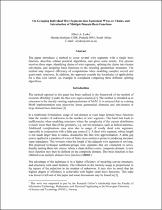 ResearchSpace
ResearchSpace
On grouping individual wire segments into equivalent wires or chains, and introduction of multiple domain basis functions
JavaScript is disabled for your browser. Some features of this site may not work without it.
- ResearchSpace
- →
- Research Publications/Outputs
- →
- Conference Publications
- →
- View Item
| dc.contributor.author |
Lysko, Albert A

|
|
| dc.date.accessioned | 2009-09-17T08:38:45Z | |
| dc.date.available | 2009-09-17T08:38:45Z | |
| dc.date.issued | 2009-06 | |
| dc.identifier.citation | Lysko, A.A. 2009. On grouping individual wire segments into equivalent wires or chains, and introduction of multiple domain basis functions. IEEE International Symposium on Antennas & Propagation and USNC/URSI National Radio Science Meeting, North Charleston, South Carolina, USA, 1-5 June, 2009. pp 1-4 | en |
| dc.identifier.isbn | 978424436477 | |
| dc.identifier.uri | http://hdl.handle.net/10204/3599 | |
| dc.description | This paper was presented at IEEE International Symposium on Antennas & Propagation and USNC/URSI National Radio Science Meeting, North Charleston, South Carolina, USA, 1-5 June 2009 | en |
| dc.description.abstract | The paper introduces a method to cover several wire segments with a single basis function, describes related practical algorithms, and gives some results. The process involves three steps: identifying chains of wire segments, splitting the chains into shorter sub-chains, and assigning basis functions to the resulting geometrical structures. The method may improve efficiency of computations when modeling complex curved and quasi-static structures. In addition, the approach extends the boundaries of applicability for a thin wire kernel. An example is considered comparing three different splitting algorithms. | en |
| dc.language.iso | en | en |
| dc.publisher | IEEE | en |
| dc.subject | Wire segments | en |
| dc.subject | Equivalent wires | en |
| dc.subject | Multiple Domain Basis Functions | en |
| dc.subject | MDBF | en |
| dc.subject | Meander monopole | en |
| dc.subject | Splitting algorithms | en |
| dc.subject | Computations | en |
| dc.subject | Wires | en |
| dc.subject | Chains | en |
| dc.subject | Radio science | en |
| dc.title | On grouping individual wire segments into equivalent wires or chains, and introduction of multiple domain basis functions | en |
| dc.type | Conference Presentation | en |
| dc.identifier.apacitation | Lysko, A. A. (2009). On grouping individual wire segments into equivalent wires or chains, and introduction of multiple domain basis functions. IEEE. http://hdl.handle.net/10204/3599 | en_ZA |
| dc.identifier.chicagocitation | Lysko, Albert A. "On grouping individual wire segments into equivalent wires or chains, and introduction of multiple domain basis functions." (2009): http://hdl.handle.net/10204/3599 | en_ZA |
| dc.identifier.vancouvercitation | Lysko AA, On grouping individual wire segments into equivalent wires or chains, and introduction of multiple domain basis functions; IEEE; 2009. http://hdl.handle.net/10204/3599 . | en_ZA |
| dc.identifier.ris | TY - Conference Presentation AU - Lysko, Albert A AB - The paper introduces a method to cover several wire segments with a single basis function, describes related practical algorithms, and gives some results. The process involves three steps: identifying chains of wire segments, splitting the chains into shorter sub-chains, and assigning basis functions to the resulting geometrical structures. The method may improve efficiency of computations when modeling complex curved and quasi-static structures. In addition, the approach extends the boundaries of applicability for a thin wire kernel. An example is considered comparing three different splitting algorithms. DA - 2009-06 DB - ResearchSpace DP - CSIR KW - Wire segments KW - Equivalent wires KW - Multiple Domain Basis Functions KW - MDBF KW - Meander monopole KW - Splitting algorithms KW - Computations KW - Wires KW - Chains KW - Radio science LK - https://researchspace.csir.co.za PY - 2009 SM - 978424436477 T1 - On grouping individual wire segments into equivalent wires or chains, and introduction of multiple domain basis functions TI - On grouping individual wire segments into equivalent wires or chains, and introduction of multiple domain basis functions UR - http://hdl.handle.net/10204/3599 ER - | en_ZA |





